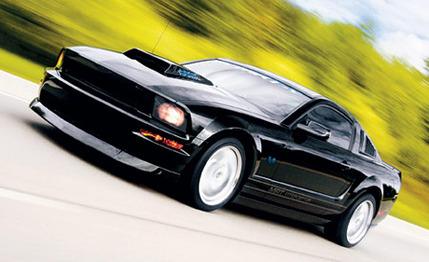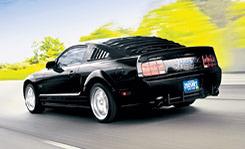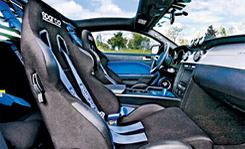 Specialty File
Specialty File
We're going to have to do some digging to get to what really interests us about this Mustang. What we're after is past the headlight covers that can change between clear and dark, the airbrushed paint, the glass roof, the lowered suspension, and the TV screen: a centrifugal supercharger kit from Paxton that can reportedly boost the Mustang's 300-hp V-8 to 470.
You might wonder why a Mustang GT owner would consider adding a supercharger when Ford is about to produce a factory supercharged version, the Shelby Cobra GT500, which will have more than 450 horsepower.
The answer is money. We don't yet know the price of the Cobra, but we expect it to cost close to 40 grand. The supercharger here comes in two flavors: a base kit that costs $3890, does not come with an intercooler, and increases horsepower to a claimed 420; and a $4895 high-output kit that comes with an intercooler and supposedly makes 470 horsepower. Either way, if you add in another $600 for the labor to install the kit and the sticker price of a Mustang GT ($25,815), you have a very high-performance Mustang for thousands less than the factory-blown Cobra. You could also save money by doing the installation yourself.
The kits come with everything you need to do the job. There's also a plug-in controller that modifies the engine computer to work with the supercharger. That last bit is where the bulk of the development time was spent. The engine computer basically has a set of timing instructions for how much fuel to inject and when to fire the spark plug. In tuner speak, these instructions are called "maps," because the fuel and timing points vary according to rpm and throttle position.
 The Interceptor was built by a Michigan-based company called MRT, short for Mustang Racing Technologies. It was started in 2002 by Scott Hoag, a 17-year veteran of Ford engineering who led the development of the Mustang Mach 1 and Bullitt and is a mere 44 years old. The Mustang he brought us originally served as a SEMA show car--that's why it was lathered with all kinds of extraneous eye candy.
The Interceptor was built by a Michigan-based company called MRT, short for Mustang Racing Technologies. It was started in 2002 by Scott Hoag, a 17-year veteran of Ford engineering who led the development of the Mustang Mach 1 and Bullitt and is a mere 44 years old. The Mustang he brought us originally served as a SEMA show car--that's why it was lathered with all kinds of extraneous eye candy.
To the appearance items Hoag added a $500 set of headers and a $723 flywheel and clutch that are 23 pounds lighter than the stock setup. He also used the standard, nonintercooled kit and tweaked the engine maps because he determined that the ones from Paxton had compromised drivability in return for high-horsepower numbers. As a result, Hoag says that with his setup the blower adds 90 horsepower, not Paxton's claimed 120, and the headers contribute another 10 for a 400-hp total.
That lighter flywheel and clutch had a dramatic effect on the feel of the Mustang's 4.6-liter V-8. Whereas the stock engine responds a bit lazily to throttle punches, the MRT's motor felt as if it were on amphetamines, responding crisply to blips and immediately losing rpm when lifting off the gas.
The Interceptor felt great, but the downside was clutch effort that had been elevated to workout territory, not pleasing on a daily basis. But by reducing rotating inertia, the lighter clutch and flywheel should further increase performance.
Unfortunately, the show-car doodads packed on speed-losing pounds. The MRT Interceptor weighed 3756, 181 more than the last Stang we tested ("21st-Century Muscle Cars," C/D, January 2005), so the MRT car was basically burdened by the equivalent of a passenger during testing.
For reference, the January '05 car ran to 60 mph in 5.1 seconds and through the quarter in 13.8 seconds at 103 mph. By our calculations, a 400-hp Mustang that's saddled with an extra 181 pounds should do the quarter in roughly 12.7 seconds.
 The Interceptor didn't quite hit that mark, but it was still a bunch quicker than the stocker. It knocked 0.6 second off the 60-mph sprint, dropping the time to 4.5 seconds, and covered the quarter-mile in 13.2 seconds at 108 mph. Once the Interceptor got going, though, the gap widened dramatically. At 130 mph, the clock read only 22.8 seconds for the Interceptor, which was 2.8 seconds quicker than the stocker. If we do the reverse math based on quarter-mile time, the MRT's output is closer to 375 horsepower. But if the math were perfect, we wouldn't have to test cars, and there was the issue of that clutch, which acted like an on/off switch and made launching the car a tricky exercise. We probably lost a few tenths from the git-go. Considering how much quicker the MRT Interceptor was at the 130-mph mark, we think 400 horses is about correct.
The Interceptor didn't quite hit that mark, but it was still a bunch quicker than the stocker. It knocked 0.6 second off the 60-mph sprint, dropping the time to 4.5 seconds, and covered the quarter-mile in 13.2 seconds at 108 mph. Once the Interceptor got going, though, the gap widened dramatically. At 130 mph, the clock read only 22.8 seconds for the Interceptor, which was 2.8 seconds quicker than the stocker. If we do the reverse math based on quarter-mile time, the MRT's output is closer to 375 horsepower. But if the math were perfect, we wouldn't have to test cars, and there was the issue of that clutch, which acted like an on/off switch and made launching the car a tricky exercise. We probably lost a few tenths from the git-go. Considering how much quicker the MRT Interceptor was at the 130-mph mark, we think 400 horses is about correct.
The other performance modifications done to the suspension, brakes, and tires didn't accomplish much. Skidpad grip fell from 0.89 g to 0.86 g due to excessive understeer, and the braking distance from 70 mph to a standstill was 169 feet, one foot better than stock. Those components, said Hoag, were pretty much thrown on for the SEMA show and had not been optimized, as the company spent the majority of its time fine-tuning the engine calibration. The motor did behave flawlessly.
Although we wouldn't have asked for the show-car stuff, some of it was cool. The dark headlight covers turned transparent at the flick of a switch, and we watched the local news on the dash-mounted TV screen while we waited for our turn at the test track. That stuff costs real money, though, and the as-tested price was a chilling $52,569.
For Mustang fans, maybe the most important thing is that with this blower kit there's no need to hide from that $33,690 Pontiac GTO that can hit 60 mph in 4.8 and run the quarter in 13.3 at 107 mph.
Mustang Racing Technologies, 21061 Brickscape Drive, Northville, Michigan 48167; 248-449-4034;www.mrt-direct.com.